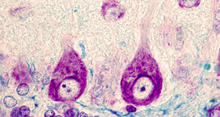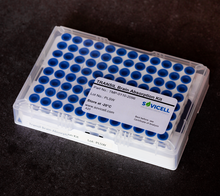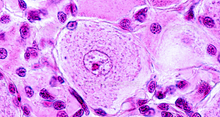The TRANSIL Brain Absorption kit estimates the binding of drugs to brain tissue and predicts the disposition of drugs into brain. It measures the affinity of drugs to reconstituted porcine brain membranes. The brain membrane affinity is used to estimate the brain tissue binding and to predict the brain-to-plasma distribution via a hybrid model that also incorporates the drug’s polar surface area and its plasma protein binding. Internal quality controls provide easy assessment of recovery, experiment and data quality.
The kit consists of ready-to-use 96 well microtiter plates. One plate can be used for measuring HSA binding of up to 12 compounds. The assay requires only 5 steps: (i) addition of drug candidate, (ii) mixing and incubation for 12 minutes, (iii) removal of beads by centrifugation, (iv) sampling of supernatant, and (v) quantification of drug candidate.
 Figure 1: Comparison of brain tissue binding measurements obtained with the TRANSIL Brain Absorption assay kit and dialysis.
Figure 1: Comparison of brain tissue binding measurements obtained with the TRANSIL Brain Absorption assay kit and dialysis.
Brain tissue binding plays an essential role in the effectiveness and safety of drugs intended to treat central nervous system (CNS) diseases. This process determines the extent of partitioning into brain tissue, which affects the drug's CNS penetration, efficacy, and toxicological effects.
Key facts about brain penetration:
- Brain tissue binding is crucial in determining the effectiveness and safety of drugs intended to treat CNS diseases.
- Brain tissue binding is primarily driven by the affinity of drugs to brain lipid membranes.
- There are little species difference in brain lipid composition, thus it is not required to measure brain tissue binding in more than one species.
- Assuming passive equilibrium, it is expected that brain to plasma drug exposure levels for any species will be predicted by the relative ratio of free fractions in these matrices.
- Outcomes of the assay are:
- Brain membrane affinity
- Free fraction in brain: fu,brain
- Brain-to-plasma distribution: logBB or Kp
- Unbound brain-to-plasma distribution: Kp,uu
- TRANSIL smart dialysis is more accurate and reproducible than equilibrium dialysis and its 96 well format is perfectly suited for high-throughput screening.
The assessment of the unbound drug fraction in the brain is a valuable tool to identify potential therapies for central nervous system (CNS) diseases. For many years, the focus has been on determining the brain/plasma ratio (Kp or logBB) as an indicator of brain penetration. However, in many cases, the total concentration of drugs in the brain (Cbrain) has little or no correlation with a mechanistic pharmacodynamic response. Nowadays, Cbrain is measured in in vivo experiments and corrected for the fraction of drug that is unbound, which is determined through in vitro experiments, to obtain an estimation of the brain unbound concentration (Cu,brain). This method has been proven to be successful across various CNS targets as it correlates better with receptor occupancy and pharmacodynamic endpoints.
Sovicell enables consistent, high-quality data with superior cost-efficiency based on internal quality control, and 96 well plate formats for high-throughput ADME screening.









